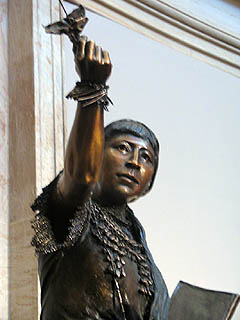A bronze likeness of Sarah Winnemucca, a Paiute woman from Nevada, was
dedicated at the U.S. Capitol on Wednesday more than 100 years after
the activist, educator and renowned speaker came to Washington to
lobby for equal treatment of her people.
Led by Rep. Jim Gibbons (R-Nevada), a parade of state and national
leaders hailed Winnemucca as a woman of many first. Among her
historic achievements: the first
Indian woman to publish a book, the first Indian woman
to open her own school and the first Indian woman to lecture
audiences throughout the country.
"Indian women have played an important role in our nation's
history," said House Speaker Dennis Hastert (R-Illinois).
With those praises, Winnemucca took her place as an official representative of
the state of Nevada at the National Statuary
Hall. She is one of only two Indian women -- North Dakota's Sakakawea is
the other -- and just one of only eight women
to receive such a high distinction.
"It is a wonderful tribute to a Native Nevadan and a Native American,"
said Gov. Kenny Guinn (R).
Ironically, Winnemucca joins former U.S. Senator Patrick McCarran
as Nevada's other statue -- each state is allowed two. As Winnemucca
pressed the federal government to live up to its promises to
the Paiutes, McCarran fought to take land away from the tribe.
That kind of struggle was typical of Winnemucca's life during the
1800s. In order to rescue the Northern Paiute Band from imprisonment
in Bannock tribal territory, she helped the U.S. Army put down
a Bannock uprising.
She led her people a 230-mile journey back to their homeland
in western Nevada, rarely stopping for food or rest, but the freedom
was short-lived. Her loyalty was punished by the government's
forced removal of the Paiutes, first to a reservation in
Nevada, then to Oregon and, finally, to Washington state.
It was this injustice that prompted Winnemucca to travel to
Washington, D.C., in 1880 to meet with President Hayes and then-Interior
Secretary Carl Schurz. She secured from them a promise to
allow the Paiutes to return home again but that pledge was
quickly broken.
Winnemucca, whose Paiute name was Thocmetony, or shell flower,
ended up taking her case directly to the American public,
first lecturing in California and later throughout the East Coast
about the unfair treatment of her tribe.
At the time, non-Indian women weren't allowed to vote, much less
express independent views.
Winnemucca eventually published a book, Life Among the Piutes, in 1883,
and opened a school for Indian children in Nevada. But several years
later, she died at the age of 47 in October 1891.
"Sarah spoke on behalf of her people and she also struggled to
improve their daily lives," said House Minority Leader Nancy Pelosi
(D-California). "Sarah Winnemucca lived her life between two worlds
and it could not have been easy."
The 7-foot bronze sculpture is the 99th statue to join the national
hall. It is one of several representations of Native leaders,
including Shoshone Chief Washakie of Wyoming, Sakakawea of
North Dakota and Cherokee leader Sequoyah of Oklahoma and
Cherokee humorist Will Rogers of Oklahoma.
The 100th, and final, statue in the hall also represents
a Native person. In September of this year, the state of New
Mexico will install a bronze likeness of Pope, a San Juan Pueblo
man who led the 1680 Pueblo Revolt to gain freedom and independence
for Pueblo tribes. The statue is the only one in the hall created
by an enrolled tribal member, Cliff Fragua of Jemez Pueblo.
Relevant Links:
Sarah Winnemucca Biography -
http://www.unr.edu/wrc/nwhp/biograph/winnemucca.htm
National Statuary Hall Collection� -
http://www.aoc.gov/cc/art/nsh
National Statuary Hall Gallery -
http://www.virtualology.com/hallofusa/nationalstatuaryhall
